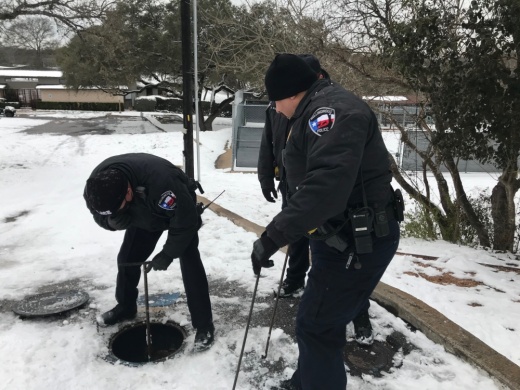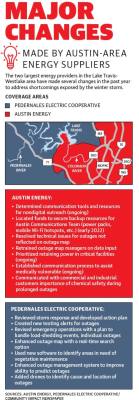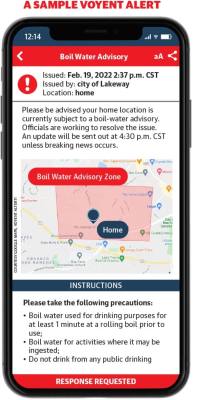Winter Storm Uri left many Texans without power and water for days. For residents in far West Austin, the disconnect between the county, smaller cities and residents created uncertainty surrounding the severity of the situation and whether help was on the way. The inability to rely on Travis County for information and assistance has led to many changes within local government to prepare for future emergencies on a hyper-local level, Lakeway Mayor Tom Kilgore said. This includes increasing citywide communication and coordination, focusing on challenges uniquely facing residents and encouraging individual emergency preparedness.
“We need to get individuals involved, because all disasters start out locally,” said Paul Harvey, the recently hired joint emergency management coordinator for Bee Cave and Lakeway. “We build that community response that gets everybody prepared a little bit more than we were last year, because we learned so much from that storm.”
Increasing communication citywide
In the year since the storm, area officials have worked on increasing communication between cities and with residents. One change made by Bee Cave and Lakeway was the introduction of the Voyent Alert system, a reverse-911 communication service aimed at keeping citizens informed during emergency situations, Harvey said. This system allows residents to receive alerts through a mobile app, text messages, email and a landline voice call about potentially life-threatening emergencies or major disasters.“It is our desire to have the Voyent Alert system as the primary means of communicating with residents in times of an emergency,” Kilgore said. “Many people are used to alternate platforms and other social media, and our hesitation is that you never know when a social media platform might be limited to you or might decide it needs to screen the information before it’s posted. Those are unacceptable parameters for a city to transmit emergency information.”
When a propane gas truck overturned on Flint Rock Road in September, Lakeway city staff informed residents and told them when to expect the next update, which went from every two hours to every four hours as things slowed down, Kilgore said. This system of regular updates will similarly be utilized in the new alert system. The city is urging citizens to join the service, which has
1,200 residents signed up to receive alerts in Lakeway and 542 signed up in Bee Cave, according to city officials.Lack of coordination between local and county officials also became an issue during the winter storm, Kilgore said. Travis County fell short in communicating with smaller cities outside of Austin concerning important information about the storm, prompting Lakeway and Bee Cave to work more closely in their own coordination efforts moving forward, he said.
“The identified shortfall that remains is that the county has not reached out to establish backup means of communication in an emergency with the local governing bodies,” Kilgore said. “We have to be self-sufficient. I cannot depend on Travis County for information or help.”
Ann Howard is the county commissioner for Precinct 3, which encompasses most of the Lake Travis-Westlake area. Among other duties, the county commissioner works under the county judge on emergency response and public health coordination efforts. During the initial storm, Howard advocated to allocate resources for West Austin residents during a time when much of the situation was unclear, she said.
“Where it’s just so difficult is that we had the storm in the middle of a pandemic, and as much as we wanted to learn from the storm and be better prepared, it’s the same professionals working on the pandemic response as the storm response,” Howard said. “Those small teams have been overtaxed with work, and I’m confident we all wish we were further along.”Since the storm, Kilgore said it has felt as if Howard is the only one on the county level advocating for residents in Lake Travis-Westlake.
Focusing on residents
A month before the one-year anniversary of the storm, the sixth and final report on the storm from Texas Health and Human Services raised the storm-related death count to 246 people. Among those deaths, over 59% were age 60 and older.
Rollingwood previously developed a list of vulnerable residents, including seniors, that was used during the winter storm to check in and ensure they had food, water and a means of staying warm, Rollingwood Police Chief Jason Brady said. Other cities nearby have since taken similar steps to develop a running list of residents to keep tabs on during emergencies.
Due to the hilly terrain of Rollingwood, an electric-powered system is used to pump sewage up the landscape through lifts and to its destination. When power went out in the city during the storm, Rollingwood public works staff worked around the clock to keep sewage flowing properly and prevent backflow from flooding into homes and into Lady Bird Lake, Brady said. The city has purchased stand-alone backup generators in the past year to station at each lift and prevent the potentially disastrous consequences of a sewage overflow from materializing.
Cities also are planning to upgrade their emergency response vehicles to handle severe weather conditions, officials said. Several cities did not have vehicles capable of traversing snow when the storm hit in February, prompting cities such as Bee Cave to purchase four-wheel drive vehicles to increase mobility in icy conditions. While Rollingwood did have a four-wheel drive vehicle, Brady said there was an emergency response vehicle from Travis County Emergency Services District 9 stationed in the city during the storm.
The city is coordinating with District Fire Chief David Wilson to potentially provide future increased fire and emergency medical services.West Lake Hills officials also have worked to build closer relationships with several emergency response partners to obtain resources and assistance during emergency situations, including the Texas Division of Emergency Management, Police Chief Scott Gerdes said. The city additionally is looking into the possibility of pretreating major roadways prior to snow or ice events to increase the ability to respond to emergencies, Gerdes said.
In addition to actions taken by the city, energy providers also have taken measures to significantly increase their outage communication with customers. Pedernales Electric Cooperative and Austin Energy, the two largest providers for the Lake Travis-Westlake area, each have implemented plans to alert customers to outages and have developed updated outage maps to more accurately reflect real-time changes in service interruption, according to the providers.
Individual preparedness and planning
Alongside citywide planning, local officials are encouraging residents to develop individual plans for safety in the event of an emergency. This includes an effort called First 72 on You, in which residents should have enough water, food, clothing and other necessities for the first three days of an emergency while awaiting aid. The plan also emphasizes developing a family emergency plan consisting of where to go, what to do and who to contact when emergencies occur.
Initiatives have been developed in neighborhoods to create coordination plans during emergencies, Howard said. Community organizations such as Go Austin Vamos Austin have worked in the past year to increase community resiliency and ensure the equitable distribution of resources during emergency situations, she said.
“[Residents] know best what works in their neighborhoods,” Howard said. “Maybe there is an elementary school that doesn’t flood and didn’t lose power, so maybe that’s the place to go—really to break down our community by neighborhood and working with that to develop their own strategy.”
There also has been an increased demand for generators and solar panel installation since the storm to prepare for potential outages. In a typical year, Austin Energy has two to three requests for whole-home standby generator installations, but since the storm officials reported over 400 requests for installation, according to a press release from the utility. There also has been a large influx of solar panel installations processed this year, equaling more than the last five years combined.
“I don’t think anyone could have ever imagined that we could have a storm that would literally shut us down for eight or nine days,” Bee Cave Mayor Kara King said. “Some things you just can’t predict they’re going to happen, so you’ve got to be ready for them if and when they do.”








